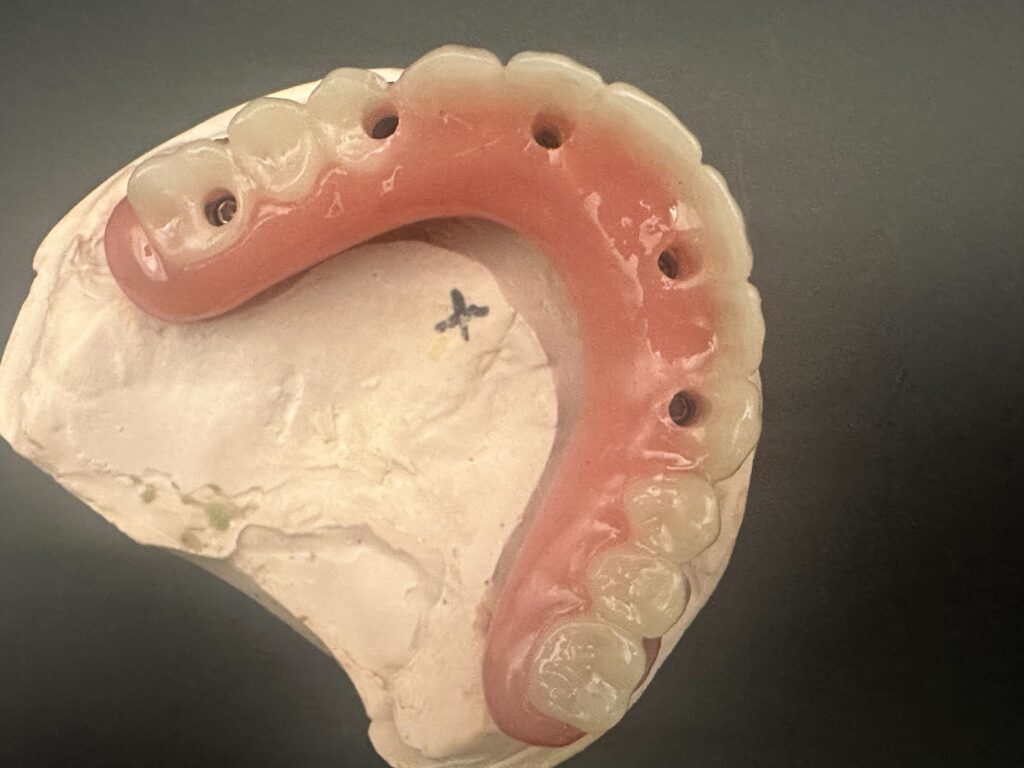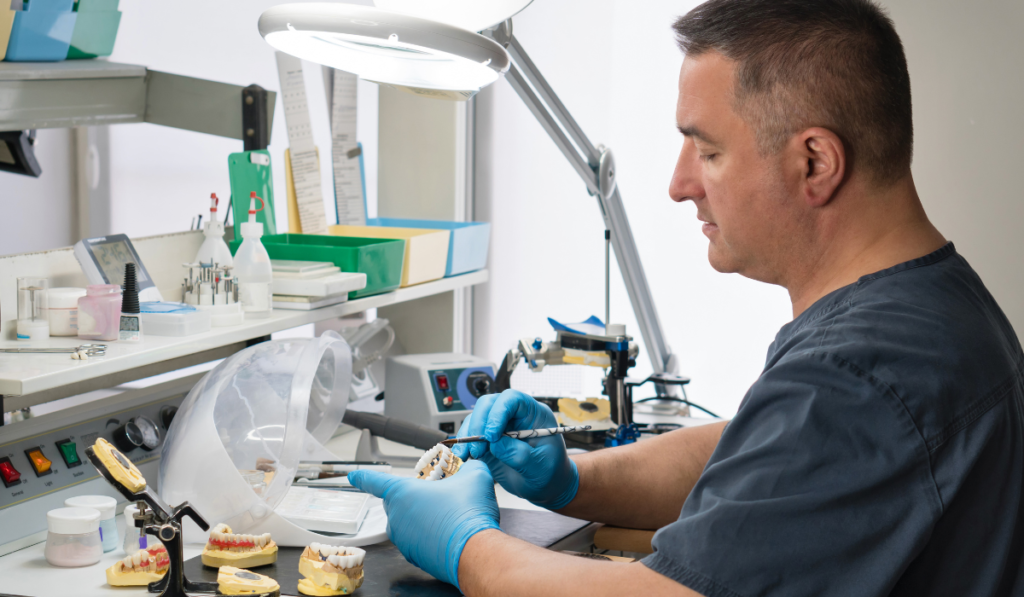All-on-X dental implants have become a cornerstone treatment for restoring edentulous arches and significantly improving patient quality of life.
But, while capable of restoring nearly any smile, meticulous planning is paramount to ensuring predictable, long-lasting success in these complex procedures.
Here, we’ll take a look at a few key considerations and planning stages to optimize All-on-X treatment for your patients.
First Things First during all-on-x planning
So, before diving into the specifics, we need to be clear about a few things.
Namely, All-on-X procedures might not be right be every patient, or even every practice. And, even if they’re a good fit for you and your patient, you’re probably going to need to collaborate with other doctors, professionals, and of course, your dental lab, to ensure a successful procedure.
For instance, in some patients, insufficient bone density may present significant hurdles to the procedure. Insufficient density, as well as other health issues (such as uncontrolled diabetes), can all but eliminate chances of a successful procedure if not addressed beforehand.
As such, ensure you collaborate with specialists when needed, including oral surgeons and periodontists, who become critical when evaluating bone structure. All-on-X planning takes time to get right, and relying on experts like these can prove invaluable.
But, assuming you’re comfortable tackling the procedure, what else goes into All-on-X planning?
Patient Selection: Tailoring Treatment to the Right Candidate
While All-on-X offers a compelling solution for many patients, careful selection is essential. Although a fantastic option for many, it’s certainly not suitable for everyone.
When considering candidacy for All-on-X treatments, take into account the following factors:
- Bone Assessment: Like other implant techniques, adequate bone volume and density are prerequisites for implant stability. Utilize advanced imaging techniques such as cone-beam CT scans to precisely assess bone quality, and plan implant placement accordingly.
In some situations, bone grafting procedures might be necessary to augment bone volume before implant surgery.
Here, especially, is where collaborating with oral surgeons or periodontists can become critical. You may need to rely on their advice and expertise before proceeding with your case.
- Periodontal Health: Existing gum disease requires effective treatment before proceeding. Healthy peri-implant tissues remain vital for long-term implant success.
To that end, collaborate with hygienists to establish a comprehensive pre-operative periodontal therapy plan, if necessary. - Medical History: Certain medical conditions might necessitate additional considerations or specialist consultations to ensure proper healing.
Uncontrolled diabetes, for instance, can raise risk of infection & poor healing, while bone diseases like osteoporosis or Paget’s disease may require their own additional treatments.
Clear communication with your patients regarding their medical history is crucial during All-on-X planning to determine their suitability for treatment. Unless they’re fully aware of the risks, responsibilities, and requirements post-op, the outcome may ultimately fail to meet expectations and hopes.
Pre-Treatment : Building a Digital Roadmap During All-on-x planning
Thorough pre-treatment planning lays the groundwork for a successful All-on-X procedure. Here are key steps you’ll need to take:
- Comprehensive Examination: Perform a detailed clinical examination to assess jaw anatomy, remaining dentition (if any), and potential occlusal concerns. 3D imaging provides invaluable data for implant placement planning.
- Digital Smile Design (DSD): Leverage DSD software to collaboratively design the final restoration with your patient. This allows for visualization of the desired aesthetics, implant positioning, and provisionalization strategy.
- Treatment Plan Development: Develop a detailed treatment plan outlining the number, size, and angulation of implants, the chosen restoration material (e.g., zirconia, acrylic, etc.), and any necessary preparatory procedures like bone grafting or extractions, for instance.
Implant Placement and Restoration Considerations
Careful consideration of these factors optimizes implant placement and restoration design:
- Number and Positioning of Implants: The number of implants typically ranges from 4-6, strategically placed to distribute occlusal forces evenly and minimize bone resorption.
Advanced planning software facilitates precise implant positioning and minimizes the risk of nerve impingement. - Immediate vs. Delayed Loading: The decision between immediate or delayed loading protocols depends on individual patient factors and bone quality.
Immediate loading can offer a faster treatment timeline, and patients can potentially leave the surgery with a fixed provisional restoration, improving aesthetics and function immediately. Some patients also choose this method because it reduces the number of surgical procedures involved, eliminating the need for a separate procedure to place the permanent restoration
However, it can also place a heavier strain on the body’s healing process, leading to more pain and discomfort than a delayed loading approach. And, if bone density is insufficient, it may not be a realistic option in the first place.
Delayed loading, on the other hand, tends to provide a lower risk of implant failure. It allows for complete bone healing around the implants before placing the permanent restoration, potentially improving long-term success rates.
However, with its longer treatment timeline, patients may need to wear temporary dentures, or remain edentulous for a period after implant placement, before receiving the final restoration.
Discuss the most suitable approach with your patient, considering factors like their desired timeline and potential post-operative sensitivity. - Provisional Restoration Design: Provisional restorations play a crucial role in patient comfort, aesthetics, and osseointegration during the healing period.
Design provisional restorations that promote proper healing and maintain a functional, aesthetic smile throughout treatment.
Communication and Collaboration: Keys to Success
Effective communication and collaboration with your team, including other surgeons, hygienists, and dental labs, remain essential throughout the All-on-X planning process.
Clearly communicate treatment plans, ensure proper implant selection and fabrication, and establish protocols for peri-operative and post-operative care.
Delivering Exceptional Care with All-on-X
By meticulously considering patient selection, implementing a comprehensive pre-treatment planning process, and carefully designing implant placement and restoration, you can achieve predictable and successful All-on-X outcomes.
As with any procedure, ongoing patient education regarding post-operative care and the importance of maintaining good oral hygiene is vital for long-term implant success.
Of course, some All-on-X procedures are just more challenging than others, whether it’s due to poor bone density or any number of other complications.
And sometimes, you just need a little help during the planning phase.
If so, you can always reach out to First Choice for advice & treatment options. Our experienced team has helped countless dentists plan thousands of cases over the years.
And, no matter how complex a case may be, we’re happy to extend our knowledge to help you create that perfect smile for your patient.
Simply reach out to us today, and see how smooth the process can be.
How can we help you create a smile today?
***
About First Choice Dental Lab
First Choice Dental Lab is a full-service dental lab with locations in Downers Grove, Il. & Wauwatosa, Wi.
We manufacture & customize quality dental restorations for general dentists. We create smiles based on your needs and budget.
We’re here to help you give your patients a reason to smile!
Request your fee schedule today by completing the form on this page.





